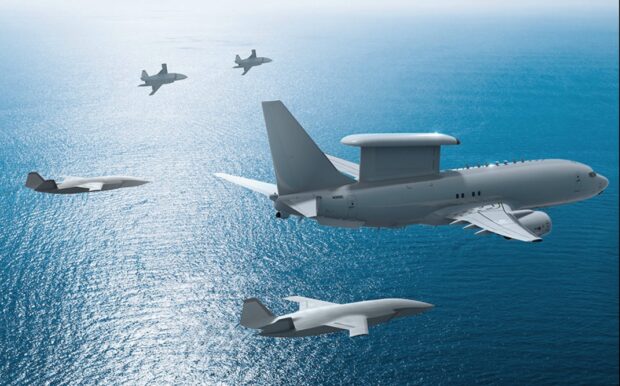The three contractors not chosen for the first increment of the Collaborative Combat Aircraft program say they’re staying in the arena and will compete for other autonomous aircraft work for the Navy, foreign governments, and in the classified domain. But only two said definitively they will compete for Increment 2 of the Air Force’s CCA.
The U.S. Air Force announced April 25 that Anduril, a relatively new startup, and General Atomics, the service’s main drone-builder over the last 30 years, each won CCA contracts. Boeing, Lockheed Martin, and Northrop Grumman, the traditional aircraft primes, were not chosen, although the Air Force said they could compete for future CCA work at their own expense.
The Air Force was not able to immediately provide details of how Anduril and General Atomics’ CCA options have been exercised or what the wins translate to in terms of funds.
Northrop Grumman chief executive officer Kathy Warden said her company is “obviously disappointed” not to be chosen, but noted that the Air Force has “described this acquisition strategy as a continuous competition, as they’re already outlining future phases. So, we’ll see what that presents in terms of a future entry point.”
Warden, speaking on an earnings call April 25, also said the Navy and foreign governments are pursuing similar programs, “and so we are pursuing those opportunities.”
“We haven’t learned anything at this point that fundamentally changes our strategy in autonomy,” she added. “But we’ll monitor how the CCA program progresses and incorporate any learnings that we have into those future opportunities.”
The company wants to expand its presence in the emerging market of CCA-like platforms, Warden said.
“We are obviously working toward affordability in our product line,” she said. “So, we do not want to be viewed as only offering exquisite and expensive technology. We’ve been working to drive down the cost of our offerings, and I think we had quite a compelling offering on CCA and can compete in that marketplace.”
She said Northrop is well-positioned to meet customer needs “against the high-end threats,” but isn’t looking to be a player in the “more commoditized part of the market: very low cost and not survivable systems. That’s just not our business model.”
Boeing, in a press release, also expressed disappointment:
“While we are disappointed that we won’t be moving forward in this phase of the U.S. Air Force’s Collaborative Combat Aircraft program, we are undeterred in our commitment to providing next-generation autonomous combat aircraft for U.S. and global military customers. Work continues on our robust and growing autonomous family, including the MQ-25 Stingray and future derivatives, the MQ-28 Ghost Bat, and a number of proprietary programs we can’t disclose.”
The Stingray is a carrier-launched, autonomous aerial tanker, while the Ghost Bat is a modular CCA-like platform developed by Boeing Australia, in partnership with the Royal Australian Air Force.
In its statement, Lockheed Martin noted that the CCA will have to work with the F-22 and F-35 fighters it builds.
The company “remains committed to advancing the state of the art in autonomous systems for air and ground missions. … For some time, we’ve been focused on bringing to life the transformative power of autonomous and AI/ML [artificial intelligence/machine learning] enabled operations in crewed and uncrewed DOD systems, with particular focus on integrating CCA with F-35 and F-22. These commitments and work are ongoing.”
Lockheed did not say, however, that it will continue competing for CCA per se, either as a manufacturer for Increment 1 or as prime on Increment 2. Asked about this, a Lockheed spokesperson said the statement stands, and noted the comment about the “commitments” and work “ongoing.”
While Northrop has said it will not pursue the Air Force’s Next Generation Air Dominance (NGAD) crewed fighter that is to replace the F-22, Boeing and Lockheed have said they are pursuing that project. The Air Force refers to the CCA as part of NGAD, funding the two under the same budget line item and describing the CCA as part of the NGAD’s “family of systems.”
Source: Air & Space Forces

